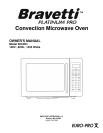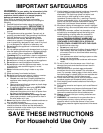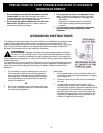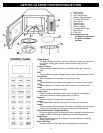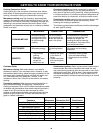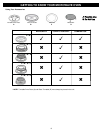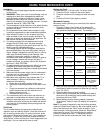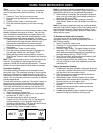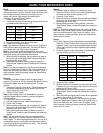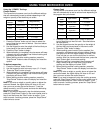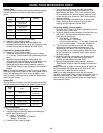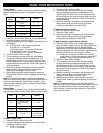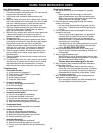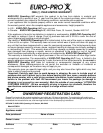
IMPORTANT SAFEGUARDS
WARNING: For your safety, the information in this
manual must be followed to minimize the risk of fire,
explosion, electric shock or to prevent property
damage, personal injury or loss of life.
When using an electrical appliance, basic safety
precautions should always be observed, including the
following:
1. Read all instructions before using the appliance.
2. Read and follow the specific “PRECAUTIONS TO
AVOID POSSIBLE EXPOSURE TO EXCESSIVE
MICROWAVE ENERGY” found on page 3 of this
manual.
3. This appliance must be grounded. Connect only to
properly grounded outlet. See grounding instructions.
4. Use this appliance only for its intended use as
described in this manual. Do not use corrosive
chemicals or vapors in this appliance. This type of
oven is specifically designed to heat, cook or dry food.
It is not designed for industrial or laboratory use.
5. Do not operate the appliance in microwave mode
when empty.
6. Do not operate appliance with damaged cord or plug or
after the appliance malfunctions or has been damage
in any manner. Return appliance to EURO-PRO
Operating LLC for examination, repair or adjustment.
7. Close supervision is necessary when any appliance is
used by or near children.
8. Do not cover or block any openings on the appliance.
9. Do not store or use this appliance outdoors.
10. Do not place or use this appliance near water, i.e. near
a kitchen sink, near a swimming pool, in a wet
basement, etc.
11. Never immerse cord or plug in water or any other
liquid.
12. Keep cord away from heated surfaces.
13. Do not let cord hang over edge of a table or counter.
14. To reduce the risk of fire in the oven cavity:
a. Do not over cook food. Carefully attended the
appliance when heating food in plastic or paper
containers.
b. Remove wire twist-ties from paper or plastic bags
before placing bag in oven.
c. If materials inside the oven ignite, KEEP OVEN
DOOR CLOSED, turn the oven “Off”, and
disconnect the power cord or shut off power from
the fuse or circuit breaker panel.
d. Never use the microwave for storage. Do not
place paper products, cooking utensils or food in
the oven when not in use.
15. Never heat liquid or other food in sealed containers as
they are liable to explode.
16. The contents of feeding bottles and baby food jars
should be stirred or shaken and the temperature
should be checked on the inside of your wrist, before
serving in order to avoid burns.
17. Liquids heated in certain shaped containers (especially
cylindrical-shaped containers) may become
overheated. The liquid may splash out with a loud
noise during or after heating or when adding
ingredients (instant coffee, etc.), resulting in harm to
the oven and possible injury. In all containers, for best
results, stir the liquid several times before heating.
Always stir liquid several times between re-heating.
18. Microwave heating of beverages can result in delayed
eruptive boiling, care must be taken when handling the
containers.
19. Liquids such as water, coffee, hot chocolate, or tea
are able to be overheated beyond the boiling point.
Visible bubbling or boiling when the container is
removed from the microwave oven is not always
present. THIS COULD RESULT IN VERY HOT
LIQUIDS SUDDENLY BOILING OVER WHEN THE
CONTAINER IS DISTURBED OR A SPOON OR
OTHER UTENSIL IS INSERTED INTO THE LIQUID.
To Avoid this from occurring:
a. Do not over heat liquid.
b. Stir the liquid before and halfway through heating it.
c. After heating, allow the container to stand in the
microwave oven for a short time before removing
the container.
d. Use extreme care when inserting a spoon or other
utensil into the container.
e. Do not use straight-sided containers with narrow
necks.
20. Do not fry food in the microwave oven. Hot oil can
damage oven parts and utensils and even result in
personal injuries.
21. Some products such as whole eggs and sealed
containers should not be heated in the microwave
oven. For example, heating eggs in their shells, whole
hard-boiled eggs or closed glass jars can explode and
should not be heated in the microwave oven.
22. Pierce foods with heavy skins such as potatoes, whole
squashes, apples and chestnuts before cooking.
23. Avoid heating small-necked containers like honey or
syrup bottles.
24. Avoid using corrosive and vapors, such as sulfide and
chloride.
25. Cooking containers may become hot because of heat
transferred from the heated food. Use potholders to
remove the containers from the microwave oven.
26. Always make sure that your cooking containers are
microwave safe.
27. WARNING: It is hazardous for anyone other than a
trained person to carry out any service or repair
operation which involves the removal of any cover
which gives protection against exposure to microwave
energy.
SAVE THESE INSTRUCTIONS
For Household Use Only
1
Rev. 06/05C



